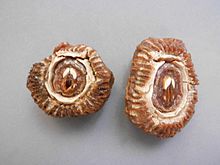| Whale barnacle Temporal range: Late Pliocene–Recent[1]
| |
|---|---|

| |
| Cryptolepas rhachianecti | |
| Scientific classification | |
| Domain: | Eukaryota |
| Kingdom: | Animalia |
| Phylum: | Arthropoda |
| Class: | Thecostraca |
| Subclass: | Cirripedia |
| Infraclass: | Thoracica |
| Superorder: | Thoracicalcarea |
| (unranked): | Sessilia |
| Order: | Balanomorpha |
| Superfamily: | Coronuloidea |
| Family: | Coronulidae Leach, 1817 |
| Genera[2] | |
| |
Whale barnacles are species of acorn barnacle that belong to the family Coronulidae. They typically attach to baleen whales, and sometimes settle on toothed whales. The whale barnacles diverged from the turtle barnacles about three million years ago.
Whale barnacles passively filter food, using tentacle-like cirri, as the host swims through the water. The arrangement is generally considered commensal as it is done at no cost or benefit to the host. However, some whales may make use of the barnacles as protective armor or for inflicting more damage while fighting, which would make the relationship mutualistic where both parties benefit; alternatively, some species may just increase the drag that the host experiences while swimming, making the barnacles parasites.
After hatching, whale barnacles go through six molting stages before searching for a host, being prompted to settle by a chemical cue from the host skin. The barnacle creates a crown-shaped shell, and in most instances, deeply embeds itself into the skin for stability while riding a fast-moving host. The shell plates are made of calcium carbonate and chitin.
Whale barnacles may live for up to a year, and often slough off along migration routes or at whale calving grounds. Because of this, fossil whale barnacles can be used to study ancient whale distribution.
- ^ "Coronulidae". Paleobiology Database. Retrieved 1 December 2018.
- ^ Cite error: The named reference
wormswas invoked but never defined (see the help page).